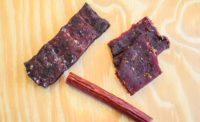For the last several years, meat snacks have been a fast-growing and profitable segment of the meat industry. New brands were launched and new flavors were introduced. Companies that co-packed for new brands had all the work they could handle.
If there was a concern that the influx of new products into the category would oversaturate the market, or that consumer tastes would change, it didn’t slow down the industry. Fortunately for those companies, the meat snack category is as strong as ever. If anything, it is evolving into new opportunities, like grass-fed meat sticks or biltong, an African style of dried beef.
According to Transparency Market Research, revenue generated from the global meat snacks market has been estimated to be valued at approximately $7.1 billion in 2019. It is projected to increase at a CAGR (compound annual growth rate) of 7%, to reach $14.5 billion by 2029. Developing countries like India, China, Brazil and Turkey are expected to be particularly strong markets for meat snacks. There is a rise of urbanization and product awareness in these developing markets that will help grow sales.
Sales are also being driven by an increase in consumer health problems, such as diabetes, obesity and heart problems. “A rise in health consciousness is being observed, giving rise to eating healthy and nutrient-rich food products. The demand for vitamin-, protein-, and omega-3-rich meat snacks is increasing,” notes a TMR report on the meat snack sector.
In the United States, meat snacks are one area where a small processor can compete with the larger companies, using quality, innovative flavors and products that meet specific consumer needs.
Western’s Smokehouse, a California, Mo., processor, introduced its Simply Good line of snack sticks in 2018. The sticks, available in eight flavors, contain only lean cuts of beef and pork and spices, and they are free of nitrites, nitrates, gluten, MSG and soy. Western’s CEO Kevin Western says that the outlook for the meat snacks markets remains strong and that the trends of today, such as better-for-you snacking, will become the norms of tomorrow.
Shortly after the launch of the Simply Good products, Western’s announced that it was shutting down its retail store, where it sold a variety of cured meat items, to focus its production on snack sticks.
“It was one of the toughest business decisions that the Western Family has had to make, but ultimately the decision was made because we needed to expand our packaging department, and the real estate that the retail store was sitting on is what we needed,” Western explains.
While it was a difficult choice, it ended up being the right one to make. “Historically, every time we have made a major decision like this, we have grown because of it, and this one is no different,” he says. “We are continuing to see amazing growth in our production of shelf stable meat snacks.”
As the company continues to build out its capacity, Western’s Smokehouse uses its product quality and superior service as ways to stand out against its larger competition.
Jumping into the meat snack market
Jesse Smith is a relative newcomer to the meat industry, but he has found several successful niches in the industry. In 2015, he and his wife, Shelly, founded Diller Locker in Diller, Neb. Earlier this year, the couple purchased C&C Processing from Smith’s brother-in-law, Chad Lottman. The sale of C&C processing allowed Lottman to focus on his Landmark Snacks business, which is a meat snack co-packer.
The launch of the locker plant came about because there was a need for slaughter services in his town. The acquisition of C&C Processing was an opportunity to jump into co-packing further processed products, such as meat snacks. Much of its operation is devoted to whole-muscle jerky, along with ground jerky, meat sticks and bars. Since adding on this RTE operation, Smith has been working with new customers to balance out the product portfolio, with more sticks and bars.
“The biggest swing that I’ve seen in my short time here is everyone converting the product they’re making now to grass-fed,” he says. “We’ve had two of our largest customers make the switch already, and it creates our own challenges. Grass-fed prices are more expensive than domestic, and they’re harder to source, so a lot of it comes from overseas. We’re dealing with overseas companies for the best products and the best price to try and build a reliable relationship with them.”
The addition of a further processing plant to Diller Locker’s operations means that Smith’s role has changed greatly.
“I was on the slaughter floor every week and the cutting floor every day,” he recalls. “Now that we’ve grown, my general manager oversees the slaughter facility, and I’m at the processing division. Mainly what I’m doing now is developing customers, trying to find the ones that align with what we’re trying to do with our business, then developing them to the level that they want to be and that we need them to be.”
Fifty years of snacking success
While the meat snacks market is filled with new entrants to the category, Old Trapper Smoked Products recently celebrated its 50th anniversary. The company, headquartered in Forest Grove, Ore., opened its state-of-the-art, 80,000-square-foot processing facility last year to keep up with the demand for its products.
“We have the good fortune at being at the intersection of some substantial consumer trends. Protein and snacking has really exploded over the last couple decades. In fact, you currently see other parts of the snacking industry fortifying their products with protein to try to keep up with this trend,” says Eric Evenson, vice president of Old Trapper.
He believes that the company will continue to lead the meat snack category in growth and innovation, thanks in part to its experience in the segment.
“We have built a great knowledge base over our 50 years in business and expect to release some exciting innovations in the next few years,” he says.
One of the company’s more recent releases was a “Big Bag” 10-ounce clear-view bag of beef jerky. The clear bag stands apart from Old Trapper’s competition, which tend to use colored bags that don’t show how much – or how little – jerky is inside.
“Consumers are really tired of the ever shrinking, half-empty package,” Evenson says. “The consumer has really responded to being able to see a great-looking product before they buy. To do it well, you really have to be able to make a great product, as there is nothing to hide behind in a clear package. We felt it was the natural next step to take that philosophy further into the beef jerky category.”
As a company that has been around for 50 years, Old Trapper has seen many microtrends come and go, and it has remained successful for all those years by maintaining its authenticity and its quality. Evenson adds that the company’s processing capabilities are a huge differentiator and a great advantage in the meat snack industry, compared to new entrants that have no processing abilities of their own. Though the number of products in the meat snack category continues to grow, the production base is not growing at the same rate.
The opening of Old Trapper’s new plant came less than a decade after a significant expansion to its original factory. That expansion, completed in 2011, came with a five-year plan to grow into the space. After two years, Evenson says, it was apparent that it wasn’t going to be sufficient. The company’s production team kept up with the demand until the new facility could open.
One advantage of a brand-new plant is that a processor can take advantage of the latest technology, and Evenson says that the entire food industry has taken a huge step forward in process improvement and efficiency.
“Plant wide production system monitoring and real time feedback has made such a difference in the ability to make incremental improvements to processes based on data,” he says. “We are now at a point where we can look for opportunities to grow based on our meat snack processing knowledge base. We are really excited about those opportunities.” IP









